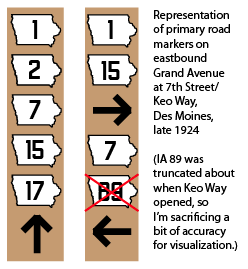
(July 1, 1920-April 1, 1941)
- In 1920, they knew it as: The road to Camp Dodge and also "Hyperion Field and Motor Club"; the former 58th Street; part of the Des Moines and Twin City Short Line (Huebinger); part of the Daniel Boone Trail (registered December 22, 1916)
- We know it as: Merle Hay Road, named for the first Iowa soldier killed in World War I
- Let's get granular: Because Keosauqua Way did not exist until the end of 1924, the route of IA 7 as shown on Jason Hancock's Highways of Des Moines page is too late for IA 89 during the time it went into downtown Des Moines.
- Based on Huebinger's Map and Guide for Panora Speedway (1912), the original route south is as follows: Merle Hay Road, Douglas Avenue, Beaver Avenue, Forest Avenue, 31st Street (by Jethro's BBQ and just west of the Drake campus), University Avenue, 28th Street, Cottage Grove Avenue, 19th Street, Woodland Avenue, 12th Street, Grand Avenue.
- Related routes: IA 95 (I), which it replaced by extension; IA 141, which replaced it; IA 401, created from a segment of 141 that served the same purpose; IA 28 (II), the number running north of Douglas Avenue today
- Merle Hay Road between Douglas Avenue and Beaver Creek has carried, at one point or another, the numbers 89, 7, 64, 141, 401, and 28. From Beaver Creek to NW 62nd, the same numbers except 28.
- Point of interest: IA 89 was the only state highway completely hard-surfaced at the origination of the system, because it was a war road made of HAND-LAID BRICK.
NORTH End: Camp Dodge, Johnston, Polk County
Monolithic
brick road to connect Camp Dodge and the City of Des Moines
Monolithic brick pavement, 20 feet wide, with 6 feet of double course
gravel on either side, making a 32 foot surface, is to connect the City
of Des Moines with Camp Dodge, at the earliest possible date. This will
not only be Iowa's first military road but it will be the finest stretch
of rural pavement in the state.
— Iowa Highway Commission Service
Bulletin, September 1917
Winter
puts stop to Army cantonment and federal aid brick and concrete road
building
Contractors at Camp Dodge on the Merle Hay road, as the now famous
cantonment road will hereafter be known ... fought their battle against
cold and frost until Monday, December 3rd, when they gave up and went
into their winter trenches. With the first signs of a break in the
spring, they will be "over the top" with the final onslaught against the
mud and ruts which has at times all but made the roads between Des
Moines and the great army camp impassable.
When the last brick was laid on the afternoon of December 3rd, 11,800
feet, considerably more than two miles of surfacing had been completed
of the 4 1/8 miles between the camp and the city limits. [Aurora
Avenue -Ed.]
— Iowa Highway Commission Service
Bulletin, November-December 1917
The completed Merle Hay Road, which combined with the segment inside Des Moines offered 12 miles of brick, was dedicated on July 27, 1918.
SOUTH End (1): Des Moines, Polk County

Since 12th Street was west of downtown Des Moines, it probably got marked eastward on Grand Avenue, likely to 7th Street where Grand intersected IA 1. Panora Speedway officially ended on Grand at 5th Avenue, where (totally coincidentally, I'm sure) Huebinger's Iowa Publishing Co. was located. Today's intersection of 12th and Grand looks nothing like it would have then.
SOUTH End (2): IA 7, now Merle Hay Road at NW 62nd Ave., Johnston, Polk County
Johnston, now among the top 25 cities in Iowa by population, was founded in 1905 but wasn't officially incorporated until after the moon landing. Removing the redundant multiplex with IA 7 significantly shortened the route.
Page created 4/4/20